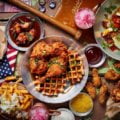As you, in all likelihood, recognize, one of the triggers for the extremely good insurrection of 1857 (or the First War of Independence or the Mutiny, depending on your angle) becomes a tale that unfolds across India. According to individuals who claimed to be within the know, the British army had coated cartridges with animal fats. Soldiers needed to bite off the covering of the cartridges to use them. This supposed that they ended up eating bits of animal fats.
But, or so went the tale, the fats came from cows and pigs. So foot soldiers have been now required to devour pork fats and red meat fat. This offended Hindus and Muslims and caused revolts in army gadgets. The British stated that no pig or cow fats were used and that the tale changed into only hearsay. However, facts are frequently remembered for less than the perception of the politicization of food. (And the Brits may have been mendacious, anyway!) Many of these days’ so-called tend to be only apapproximateonotionsThe truth seems to be remembered less and less.
In reality, I am beginning to accept that, at no point, seeing that in 1857, food was as politicized as it is today. The renewed furor about pork ingesting is typically political. The war between khichri and biryani is now not about rice dishes. It is known as Hindu foods and Muslim meals. The talk is prolonged mainly for political motives.
In the famous creativity, a cool animated film of Indian food habits persists. According to this model, properly Hindus were usually vegetarians. Meat-eating became a notable sin, and beef ingesting became an even more serious sin. Then, along came the Mughals. They promoted meat-eating. They took their biryanis throughout India and contaminated the pure vegetarian Indian tradition.
By prosecuting those who devour red meat and honoring vegetarianism, we’re told our country is going back to ancient Indian traditions. We restored this first-rate Hindu kingdom to time while gods walked the earth and peace ruled the land. The trouble with this cool animated film is that nearly every reality is inaccurate. First of all, India changed into by no means a vegetarian u. S. Whether you went North or South in historical India, the kings normally ate meat. (So did the gods in our epics.) Ancient Indian rulers did not simply eat meat or fowl. They ate tortoises, deer, peacocks, and different birds and animals.
Even in the Indus Valley Civilisation course, one of the oldest city civilizations in the world, courting again 3,000 years before the birth of Jesus Christ, animals have been raised and slaughtered for food. During the Vedic period, non-vegetarianism became common. Even Ayurveda, which we regard now as a merely Hindu vegetarian phenomenon, endorsed remedies based totally on meat.
The Jain recognized vegetarianism as being in preference to Hindu culture. Even the Buddha (who came after Mahavir and Jainism’s founding) no longer insisted on vegetarianism. (Indians are always taken aback to find out that the Dalai Lama eats meat; he ate red meat until his doctors told him to move easily on beef.) Ancient texts, including The Arthashastra, include many references to meat-eating.
So, the view that ancient Hindus were all vegetarians is a myth. What about the Mughals? What is the challenge of a lot of demonization in recent times? The whole thing that you will examine many popular Internet websites, approximately the Mughals, is incorrect. First of all, they did now not name themselves the Mughals. British historians gave That name to them centuries later, considering that Babur’s mom might also have descended from Genghis Khan. Babur himself could be horrified to have been known as a Mongol or a Mughal.












